History of obesity in the cinema: "the three fat men" (1963; 1966)
Abstract
This article aims to analyze the films "The Three Fat Men" (1963, 1966), as well as the homonymous literary work published in 1927 of these film adaptations, by the Soviet Yuri Olesha, as primary sources of the history of obesity. Methodologically, besides being a historical study, it was also characterized as a multiple case study. For the analysis of the material, the discursive analysis of the enunciation was used. For the data collection, the book was read and watched the movies, identifying excerpts that were considered relevant. After the analyzes, the results allowed to constitute statements that composed a discursive formation in which the fat ones are gluttons, rich, powerful and brave. Although it is a piece of Communist propaganda, this discursive formation diverges from the bourgeois-fat, identified in other historical sources, since the three fat men were more resemble to feudal lords than to bourgeois, in the restricted sense of this term in the Marxist doctrine. Thus, it was concluded that the materials are primary sources relevant to the history of obesity in both literature and cinema.
References
-Baecque, A. Le discours anti-noble (1787-1792) aux origines d´un slogan: “Le peuple contre les gros”. Revue d´Histoire Moderne et Contemporaine. Tomo XXXVI. 1989. p.3-28.
-Barros, J. A. História serial, História quantitativa e História demográfica: uma breve reflexão crítica. Revista de C. Humanas. Vol. 11. Num. 1. p. 163-172. 2011.
-Barros, J. A História serial e História quantitativa no movimento dos Annales. Hist. R. Vol. 17. Num. 1. p. 203-222. 2012.
-Barros, J. O projeto de pesquisa em História: da escola do tema ao quadro teórico. 9ª edição. Rio de Janeiro. Vozes. 2013.
-Ellsworth, E. Modos de endereçamento: uma coisa de cinema; uma coisa de educação também. In: Silva, T. T. (org.). Nunca fomos humanos - nos rastros do sujeito. Belo Horizonte: Autêntica. 2001. p.7-76.
-Foucault, M. Os anormais: curso no Collège de France (1974-1975). São Paulo. Martins Fontes. 2001.
-Foucault, M. A arqueologia do saber. 7ª edição. Rio de Janeiro. Forense Universitária. 2008.
-Gadamer, H. Verdade e método I: traços fundamentais de uma hermenêutica filosófica. 15ª edição. Petrópolis. Vozes. 2015.
-Goffman, E. Estigma: notas sobre a manipulação da identidade deteriorada. Rio de Janeiro. LTC. 1975.
-Martin, L. Le gros comme métaphore du bourgeois dans la presse de gauche aux XIXe et XXe siècles. In: CSERGO, Julia (org.) Trop Gros? L´obésité et ses représentations. França. Autrement. 2009. p. 213-227.
-Marx, K.; Engels, F. O manifesto do partido comunista. 2018. Disponível em: http://www.ebooksbrasil.org/adobeebook/manifestocomunista.pdf. Acesso em 08/06/2018.
-Moscovici, S. Representações sociais: investigações em psicologia social. 7ª edição. Rio de Janeiro. Vozes. 2010.
-Olesha, Y. The three fat men. 5ª edição. União Soviética das Repúblicas Socialistas: Raduga, 1987. Disponível em: https://archive.org/details/TheThreeFatMen/page/n23 . Acesso em 12/10/2018.
-Poulain, J. P. Sociologia da obesidade. São Paulo: SENAC. 2014.
-Quellier, F. Gula - história de um pecado capital. São Paulo. SENAC. 2011.
-Santolin, C. B. O nascimento da obesidade: um estudo genealógico do discurso patologizante. Dissertação de Mestrado. Pelotas-RS. Universidade Federal de Pelotas. 2012.
-Santolin, C. B.; Rigo, L. C. A obesidade e a problematização da corpulência na Idade Média. Fiep Bulletin. Volume 82. Special Edition. Article I. 2012.
-Santolin, C. B.; Rigo, L. C. Por que o termo “gordo” se tornou politicamente incorreto no Brasil? Anais do VI Congresso SulBrasileiro de Ciências do Esporte. 2012a. Rio Grande-RS.
-Santolin, C. B.; Rigo, L. C. O nascimento do discurso patologizante da obesidade. Movimento. Porto AlegreVol. Vol. 21. Num. 1. p. 81-94. 2015.
-Santolin, C. B.; Rigo, L. C. Representações da obesidade no cinema: o “burguês-gordo” em A greve (1925) de Eisenstein. Movimento. Vol. 25. e25076. 2019.
-Seixas, C. M.; Birman, J. O peso do patológico: biopolítica e a vida nua. História, Ciências, Saúde - Manguinhos. Rio de Janeiro, Vol. 19. Num. 1. 2012, p.13-26.
-Stearns, P. N. Fat history: bodies and beauty in the Modern West. Nova York. New York University Press. 2002.
-Struna, N. L. Pesquisa histórica em atividade física. In: Thomas, J. R.; Nelson, J. K.; Silverman, S. J. Métodos de pesquisa em atividade física. 5ª edição. Cap. 12. Porto Alegre. Artmed. 2007. p. 189-201.
-Tri tolstyaka. Direção de Valentina Brumberg e Zinalda Brumberg. Animação, colorido, 35 min. União Soviética: Soyusmultfilm, 1963. Disponível em: https://www.youtube.com/watch?v=wBCBSCZCsvE . Acesso em 8/10/2018.
-Tri tolstyaka. Direção de Aleksey Batalov e Iosif Shapiro. 1h e 32min, União Soviética: Lenfilm Studio, 1966. Disponível em: https://www.youtube.com/watch?v=Gm3NgTpY8fM . Acesso em 8/10/2018.
-Vigarello, G. As metamorfoses do gordo: história da obesidade. Rio de Janeiro. Vozes. 2012.
-Yin, R. K. Estudo de caso: planejamento e método. 5ª edição. Porto Alegre. Bookman. 2015.
Copyright (c) 2022 Cezar Barbosa Santolin

This work is licensed under a Creative Commons Attribution-NonCommercial 4.0 International License.
Authors who publish in this journal agree to the following terms:
- Authors retain the copyright and grant the journal the right of first publication, with work simultaneously licensed under the Creative Commons Attribution License BY-NC which allows the sharing of the work with acknowledgment of the authorship of the work and initial publication in this journal.
- Authors are authorized to enter into additional contracts separately for non-exclusive distribution of the version of the work published in this journal (eg, publishing in institutional repository or book chapter), with acknowledgment of authorship and initial publication in this journal.
- Authors are allowed and encouraged to post and distribute their work online (eg, in institutional repositories or on their personal page) at any point before or during the editorial process, as this can bring about productive change as well as increase impact and impact. citation of published work (See The Effect of Free Access).






